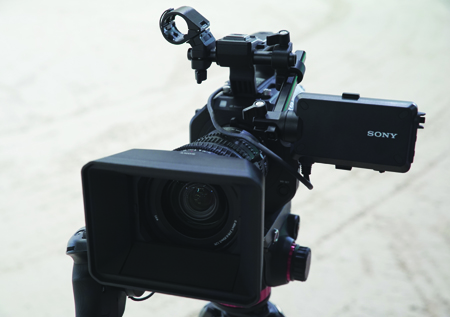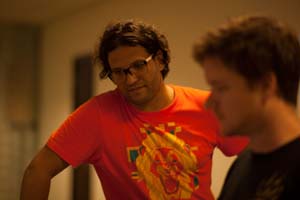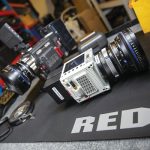The local production market has eagerly awaited the arrival of the Blackmagic Production Camera 4K, which at the humble price of USD 3,000, comes with high specs and the promise of making 4K shooting affordable. Dubai-based filmmakers Andrew Clemson and Acen Razvi, who were one of the first people to test the camera, provided BroadcastPro […]
The local production market has eagerly awaited the arrival of the Blackmagic Production Camera 4K, which at the humble price of USD 3,000, comes with high specs and the promise of making 4K shooting affordable. Dubai-based filmmakers Andrew Clemson and Acen Razvi, who were one of the first people to test the camera, provided BroadcastPro ME with an exclusive review just in time for the CABSAT show issue

Ive shot on Blackmagic cameras in one of their iterations on many different occasions. I bought the Blackmagic Pocket Cinema Camera primarily for its size, but also for the 16mm aesthetic it manages to squeeze out of such a tiny compact chassis, which I use to replace GoPros in all, but the most risky situations. Ive also used the pocket cameras larger sibling, the Blackmagic Cinema Camera (BMCC), for the occasional event or corporate job when the client wanted something more than a DSLR, but less expensive than an Alexa or an Epic.
Dubai-based Director Acen Razvi was asked to shoot a pretty intensive interview-led corporate film over six days and as he owned the BMCC and I had the Pocket Camera, he pitched the cameras as a two-angle setup. The BMCC and BMPCC have a very similar look, and it is very easy to match them in an edit.
The initial setup we had planned was to shoot using the Metabones Speed Boosters on both cameras, and sharing a set of Nikon Glass across the two, recording scratch audio to the cameras via Rode VideoMics, and recording the rest to a Zoom H6.
Luckily for us, less than a week before the shoot began, we got a call from MediaCast to notify us that they were about to receive their first shipment of Blackmagic Production Cameras 4K. This meant we would have the chance to shoot all three in tandem throughout the shoot and it provided the perfect scenario for us to test the production camera against the existing cameras, albeit a trial by fire!
The main differences between the Blackmagic Cinema Camera and the Production Camera (4K) are subtle, but massive. At first glance, the Production Camera could be mistaken for its older sibling as it shares the exact same dimensions and design. Beneath the surface, however, there are huge changes.
The Production Camera boasts a Super35 sensor, a big improvement over the Cinema Cameras sensor, which sits somewhere between the Super 16 and Micro Four Thirds (MFT) at 15.81mm x 8.88mm. This means you face less of the issues you did on the Cinema Camera in terms of crop factor. Your S35 lenses act as they should (although full-frame lenses such as the Canon L series will still be affected by the full frame to APS-C crop of 1.6X)
While the Cinema Camera is offered in a choice of Canon EF or MFT mounts, the Production Camera is currently only offered in EF mount.
To be honest, this seems an odd choice for two reasons. Firstly, the Production Camera is presented as a cinema tool, so it seems odd that there isnt a PL mount option for it. High-end jobs dont tend to be shot with SLR lenses as they arent designed for intensive use; they breathe more, and arent designed to be used in conjunction with gear such as follow focuses or matte boxes.
Secondly, there is no MFT mount option. The MFT is popular on the Cinema Camera, because one can use cheaper lightweight MFT lenses, and also because it is infinitely more adaptable to other mount formats. For my Pocket camera, I have adapters to use PL mount, Nikon F mount and Canon EF mount lenses. It seems to me that the MFT mount would have been a far more sensible option for the Production Camera.
The Production Cameras most marketable feature compared to the Cinema Camera is written right on the box. It shoots 4K video in the same flavours as the Cinema Camera RAW and ProRes. Presently, the firmware on the camera only shoots 4K in ProRes, but the 4K RAW will be implemented in future firmware builds. The camera also has a display option limited to HD, but the Blackmagic web site suggests there will be an option to output UHD resolution over 6GSDI, which I presume will also be implemented in a future build.
For our shoot, we only needed HD footage, so for the bulk (interviews and so on), we kept the Production Camera set to 1920X1080 to match the other two cameras. We had no major need for 4K on this project, and 4K ProRes will eat up a 240GB SSD in about 30 minutes so HD saved a lot of space.
We did use 4K for a few of the outdoor architectural shots, and the footage does not disappoint. The 4K is as sharp and clear as one would hope, especially when rendered to 1080P. It did a very good job of rendering the exteriors. I was worried the 4K would seem oversharp and digital and the images straight out clearly have been sharpened internally unlike competing cameras but I dont think the camera suffers because of it. It looks sharp, but natural.
Resolution aside, the images out of the Production Camera were somewhat different to the Cinema Camera. In many ways, the two are almost aesthetically identical. Colours and skin tones appear matched, despite specs stating the Production Camera actually has one less stop of DR than the Cinema Camera at 12 rather than 13. However, in the footage from the Production Camera at least to my eyes harsh highlights seemed to roll off a lot softer than those on the Cinema Camera. Overall, I found it very easy to convince myself that I was looking at an Alexa image. I think as well as being an idiot-proof partner to a Cinema Camera or a Pocket Camera, in many shooting scenarios, the footage from Production Camera could easily fool 99% of the people into thinking it was shot on an Alexa, although the Blackmagic comes at a fraction of the price.
Even if you added up all the accessories you would need to buy to make it work in a production environment, the Blackmagic is still more affordable.
The other major improvement the Production Camera has over the Cinema Camera, (and indeed most other cameras on the market) is that it ships with a global shutter rather than a rolling one.
This eliminates skew and jello vision, enabling fast whip pans and making handheld so much easier. We shot a great deal of this project handheld and on monopods in run-and-gun setups and the pictures came out looking great.
Once again, the Production Camera suffers from a lack of removable batteries, with an internal rechargeable backup battery that must be supplemented by external power, be it mains, V locks, or, in our case, Canon camcorder batteries. The good news is that all of the available externals will run the camera for hours at a time, so you dont need to carry a case full of batteries with you. We found one Switronix powerbase would last for pretty much a whole day of shooting.
My biggest, and the only real problem with the Production Camera is unfortunately true of all the Blackmagic cameras. The screen is terrible. In daylight, you cannot see anything, as it is so reflective and dim, and indoors, the viewing angle means an external monitor or EVF is essential. Otherwise, you find yourself standing on apple boxes or chairs to be able to judge exposure or focus.
But if you can find a way around that one, the Production Camera is an amazing piece of kit. Unlike its predecessors, it has shipped with no firmware teething problems (such as black suns or blooming highlights) that I noticed, and also has less of the workaround problems such as heavy crop factors.
For the price bracket, I dont think there is a better image available in a production-ready camera available today. Im not saying this is the best camera on the market but for a camera that costs less than most DSLRs, it is, at least, for now, unbeatable.
I can see the Blackmagic Production Camera 4K appearing on shoots all over the Middle East very quickly, especially as 4K becomes more readily adopted, both to supplement and replace other camera options.
I just hope rental houses do not send this camera out underequipped. If they do that, this camera will be perceived as difficult or temperamental, putting potential renters or buyers off. With modular systems, the learning curve is always higher and this can make it tricky for such systems to be as rapidly adopted as some of the others.

The Directors POV
It was really exciting to have the opportunity to work with the BMPC 4K. Although most of my deliverables for clients are still in HD 1080p, I am excited by the fact that it packs more resolution into a 1080p image and features the global shutter for less jitter on handheld/unstable shots.
The BMPC 4Ks main selling point for me is the ProRes codec, which gives me a much more robust file to manipulate and grade in post, using DaVinci Resolve and FCPX.
The fact that the Production Camera 4K is being released in only an EF mount is a little bit frustrating as most of my lenses are Nikon or MFT-compatible with the Metabones Speed Booster on my 2.5K Cinema Camera. Swapping lenses can be a bit tedious without a few decent Nikon-to-Canon lens adapters.
The ASA rating on the 4K only seems to go up to an 800 ASA limit and I am not sure if this is a firmware upgrade or a permanent option. I find the extra shallow DOF of the S35 sensor nice to work with again since the DSLR days.
Both the 2.5K and 4K cameras work well together especially for setup shoots.
Acen Razi is a post-production expert
and a filmmaker, who served as Director for this project. www.acenrazvi.com











































































